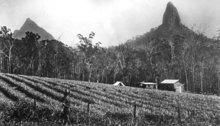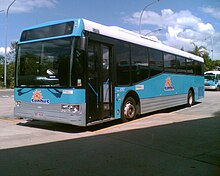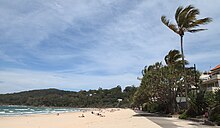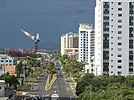Sunshine Coast, Queensland
This article needs additional citations for verification. (December 2010) |
| Sunshine Coast Queensland | |||||||||
|---|---|---|---|---|---|---|---|---|---|
|
The Glass House Mountains from Mary Cairncross Reserve; Hastings Street at Noosa Heads, Maroochydore's urban centre; Rainbow Beach, Currimundi Beach in Caloundra; The Big Cow in Nambour, Steve Irwin at Australia Zoo | |||||||||
| Population | 297,380 (2014)[1] (10th) | ||||||||
| • Density | 543/km2 (1,410/sq mi) | ||||||||
| Area | 462.4 km2 (178.5 sq mi) | ||||||||
| Location | 100 km (62 mi) from Brisbane | ||||||||
| LGA(s) | |||||||||
| State electorate(s) | Buderim, Caloundra, Glass House, Kawana, Maroochydore, Nicklin, Noosa | ||||||||
| Federal division(s) | |||||||||
| |||||||||
Sunshine Coast is a metropolitan area and the third most populated area in the Australian state of Queensland. Located 100 km north of the state capital Brisbane in South East Queensland on the Pacific Ocean coastline, its urban area spans approximately 60 km of coastline and hinterland from Pelican Waters to Tewantin. The estimated urban population of Sunshine Coast as at June 2014 was 297,380.,[1] making it the 9th most populous in the country.[citation needed]
The area was first settled by Europeans in the 19th century with development progressing slowly until tourism became an important industry. The area has several coastal hubs at Caloundra, Kawana Waters, Maroochydore and Noosa Heads. Nambour and Maleny have developed as primary commercial centres for the hinterland.
History




James Cook on the deck of HM Bark Endeavour in 1770 became the first known European to sight the Glass House Mountains, located south-west of Caloundra.[2]
In the 1820s, the Sunshine Coast saw its first white inhabitants: three castaways (Finnegan, Pamphlet and Parsons) who shared the life of the local (Kabi Kabi) Aborigines for eight months. Thereafter, during the 1830s to 1840s, the district became home to numerous runaway convicts from the Moreton Bay (Brisbane) penal colony slightly to the south.[3]
In 1842, Governor George Gipps had the entire Sunshine Coast and hinterland from Mt Beerwah north to roughly Eumundi declared a "Bunya Bunya Reserve" for the protection of the bunya tree after Andrew Petrie advised him of the importance of bunya groves in Aboriginal culture.[4] However, during the 1840s and 1850s, the Bunya Bunya Reserve and its vicinity became the scene of some of the most bitter skirmishes of Australia's "Black War". The Blackall Range, on account of the tri-annual Bunya Festival, served as both a hideout and rallying point for attacks against white settlement. By the 1850s timber cutters and cattlemen had started exploiting the area; in 1860 the Bunya Bunya Reserve was scrapped.
Many of the Sunshine Coast's towns began as simple ports or jetties for the timber industry during the 1860s and 1870s, as the area once had magnificent stands of forest. Likewise, the region's roads often began as snigging tracks for hauling timber. Timbergetters used the region's creeks, rivers and lakes as seaways to float out their logs of cedar – the resultant wood being shipped as far afield as Europe.
During the Gympie Gold Rush (1867), prospectors scaled the Sunshine Coast mountains to develop easier roadways to and from the gold fields of Gympie. After construction of the railway line to Gympie, the coastal and river towns, being mostly ports for the early river-trade, were bypassed.[5]
By the 1890s diverse small-farming (fruit and dairy) had replaced the cattle-and-timber economy of earlier decades. Sugar cane and pineapples proved especially important produce for the district. Many small hamlets and towns now emerged. Produce was initially taken by horse to Landsborough, then to Eudlo in 1891.[6]
Especially after World War II, the Sunshine Coast grew into a favoured holiday and surfing destination. This tendency was further expanded in the development boom of the 1960s and 1970s.[7] Around the same time, various tourist/theme parks were created – the most iconic being Woombye's "Big Pineapple". During the 1960s and 1970s, the Sunshine Coast also attracted persons drawn to alternative lifestyles. These newcomers developed a range of craft industries, co-operatives and spiritual centres, particularly in the hinterlands.
After the 1980s, the Sunshine Coast experienced rapid population growth. As of 2011[update] it had become one of the fastest-growing regions in Australia.[8] As the region becomes increasingly residential, most of the district's distinctive small farms – especially tropical-fruit and sugar-cane farms have disappeared, as have most of its theme parks. The Moreton sugar mills closure in 2003 removed a market for the district's 120 cane growers who had been harvesting cane in the region.[9] Instead, businesses concerned with retail, catering and tourism have assumed increasing importance.
Geography



There are many localities within the Sunshine Coast region, including the former local government areas of Maroochy Shire and the City of Caloundra as well as the current Noosa Shire. Major rivers of the Sunshine Coast include Noosa River, Maroochy River, Mooloolah River and the Stanley River. The region includes several lakes such as Lake Cootharaba and Lake Weyba. Ewen Maddock Dam, Wappa Dam and Baroon Pocket Dam have been built for water storage.
Beaches
Several stretches of the Sunshine Coast are lined with unbroken beaches – from Sunshine Beach near Noosa to Coolum Beach (17 km (11 mi)); the coast from Point Arkwright to Mudjimba (11 km (6.8 mi)); the Maroochydore–Mooloolaba stretch (5.6 km (3.5 mi)); and from Buddina past the Caloundra CBD to Pelican Waters (22 km (14 mi)). Notable beaches include:
- Noosa Main Beach
- Coolum
- Maroochydore
- Alexandra Headland
- Mooloolaba (the spit)
- Kawana Waters
- Kings Beach in Caloundra
Tourism
The Sunshine Coast is a centre for tourism, attracting more than 3.2 million visitors a year.[10] There are significant attractions, such as Steve Irwin's Australia Zoo, UnderWater World marine park, Aussie World with the Ettamogah Pub, The Buderim Ginger Factory, The Big Pineapple, the Eumundi Markets and the Majestic Theatre at Pomona.
Sports tourism is supported by several annual sporting events such as Mooloolaba Triathlon,[11] Noosa Triathlon[12] and Sunshine Coast Marathon.[13]
National parks
The Sunshine Coast region is home to more individual national parks than any other region in Queensland.[14] The natural biodiversity of the area has been protected by five separate parks in both coastal and inland regions, including Mapleton Falls National Park, Kondalilla National Park, The Glass House Mountains National Park, Noosa National Park, and the Great Sandy National Park, which includes sections on Fraser Island and in Cooloola near Rainbow Beach.
Climate
| Climate data for Sunshine Coast Airport, 1994-2016 | |||||||||||||
|---|---|---|---|---|---|---|---|---|---|---|---|---|---|
| Month | Jan | Feb | Mar | Apr | May | Jun | Jul | Aug | Sep | Oct | Nov | Dec | Year |
| Record high °C (°F) | 41.3 (106.3) |
38.7 (101.7) |
36.2 (97.2) |
33.5 (92.3) |
29.7 (85.5) |
28.3 (82.9) |
27.7 (81.9) |
35.0 (95.0) |
34.1 (93.4) |
37.0 (98.6) |
41.0 (105.8) |
38.4 (101.1) |
41.3 (106.3) |
| Mean daily maximum °C (°F) | 28.9 (84.0) |
28.8 (83.8) |
27.9 (82.2) |
25.9 (78.6) |
23.4 (74.1) |
21.3 (70.3) |
20.9 (69.6) |
22.0 (71.6) |
24.2 (75.6) |
25.6 (78.1) |
27.1 (80.8) |
28.3 (82.9) |
25.4 (77.7) |
| Mean daily minimum °C (°F) | 21.2 (70.2) |
21.3 (70.3) |
20.0 (68.0) |
16.9 (62.4) |
13.5 (56.3) |
11.4 (52.5) |
9.5 (49.1) |
9.9 (49.8) |
12.9 (55.2) |
15.6 (60.1) |
17.9 (64.2) |
19.7 (67.5) |
15.8 (60.4) |
| Record low °C (°F) | 14.5 (58.1) |
14.4 (57.9) |
10.9 (51.6) |
7.3 (45.1) |
3.5 (38.3) |
1.5 (34.7) |
−0.7 (30.7) |
1.4 (34.5) |
3.4 (38.1) |
7.6 (45.7) |
5.7 (42.3) |
10.0 (50.0) |
−0.7 (30.7) |
| Average precipitation mm (inches) | 154.3 (6.07) |
193.0 (7.60) |
161.4 (6.35) |
165.4 (6.51) |
157.4 (6.20) |
117.2 (4.61) |
66.4 (2.61) |
82.2 (3.24) |
57.1 (2.25) |
72.3 (2.85) |
83.6 (3.29) |
147.2 (5.80) |
1,478.5 (58.21) |
| Average precipitation days | 10.6 | 11.3 | 11.4 | 11.6 | 10.0 | 9.5 | 6.8 | 5.5 | 5.6 | 6.9 | 6.7 | 9.9 | 105.8 |
| Average relative humidity (%) | 70 | 71 | 69 | 68 | 65 | 63 | 59 | 59 | 63 | 66 | 67 | 69 | 66 |
| Source: Bureau of Meteorology[15] | |||||||||||||
Industry


The Sunshine Coast economy is currently dominated by three main sectors – tourism, retail and construction. The region also has a strong agricultural sector. Strong efforts are being made to diversify the regional economy - by the Sunshine Coast Regional Council and others - with an emphasis on 'clean and green' knowledge-based businesses across sectors such as information and communication technologies, cleantech, creative industries, aviation, health, education and food and beverages.
The Sunshine Coast is also emerging as a hotspot for entrepreneurial and innovative businesses. This has been partly fueled by a new wave of over 100 start-up businesses – mainly in ICT, cleantech and creative industry sectors – generated by the University of the Sunshine Coast's Innovation Centre. The University site at Sippy Downs is designated as a 'Knowledge Hub' as part of the Queensland Government's South East Queensland Regional Infrastructure Plan and is master planned as Australia's first university town based on the UK models with the potential for over 6,000 workers in knowledge-based businesses.[16] Sippy Downs was highlighted as an 'Innovation Hotspot' in July 2010, by top European Business magazine CNBC Business, with the potential to be 'Australia's no-worries-answer to Silicon Valley'.[17]
Infrastructure
Education
The Sunshine Coast's major university is the University of the Sunshine Coast with its main campus at Sippy Downs. Central Queensland University also has a campus in Noosa. TAFE Queensland services the Sunshine Coast and Wide Bay regions through TAFE East Coast, with four Sunshine Coast campuses at Mooloolaba, Maroochydore, Nambour & Noosa.
The Sunshine Coast has many varied denomination, private and public primary and secondary schools (see List of schools in Sunshine Coast). The Lexis English group, providing English classes to international students, has campuses in Noosa and Maroochydore, while Lexis TESOL Training Centres provides teacher training programs such as the Cambridge CELTA and TESOL.[18]
Health
Nambour Hospital is the region's major hospital. There are smaller hospitals located in Caloundra and Maleny but, due to limited facilities at those hospitals, most cases are referred to Nambour Hospital, thus leading to overcrowding and under-staffing at Nambour Hospital.[19]
A number of private hospitals exist throughout the region, most notably the 'Sunshine Coast Private Hospital' at Buderim, Caloundra Private Hospital (formerly known as Andrea Ahern) at Caloundra, Selangor Hospital at Nambour, the recently established Kawana Private Hospital, and smaller facilities at Noosa.
Queensland Ex Health Minister Paul Lucas initially proposed that a new public hospital be constructed in the area of Kawana, to be called the Sunshine Coast University Hospital, by 2014. However, the projected completion date has now been extended to 2016.[20]
Transport
Road
The car is the predominant mode of transport for Sunshine Coast residents, with the region connected to Brisbane via the Bruce Highway. The Nicklin Way & Sunshine Motorway are the major arterial roads, which pass through most major areas of the Sunshine Coast. Many intercity and interstate coach operators also operate daily bus services to Brisbane using the major corridors.
Public transport

The Sunshine Coast is a growing region, and has a variety of transport methods including Rail, Bus, Ferry and the Sunshine Coast Airport. However, in recent years the local council has been looking at more reliant, high quality public transport options to create a 'transport spin' on the Sunshine Coast. One of these transport methods is the Sunshine Coast Light Rail.

Plane
Flights from the Sunshine Coast depart from Sunshine Coast Airport, which is located 10 km north of Maroochydore, and fly direct to Sydney, Melbourne and Auckland with Jetstar, Virgin Australia and Air New Zealand.
Rail
Queensland Rail Citytrain's Nambour and Gympie North railway line operate interurban services daily, with most trains running express between Caboolture and Bowen Hills stations. The train lines run through the Sunshine Coast Hinterland, with buses connecting to the coastal strip. Further north of the Nambour station, commuter trains operate twice per day.
Bus
Bus services are operated by Sunbus, which operates under the TransLink public transport system. These buses connect the suburbs and localities within the Caloundra, Maroochydore and Noosa areas. Sunshine Coast Region & Noosa Shire Council operates zero-fare bus services throughout the coast to surrounding suburbs and major park and ride stations during the peak summer holiday period.
Ferry
There is a public ferry that operates between Tewantin, Noosaville, Noosa Waters, Northside and Noosa Heads.
Sport and recreation

Sunshine Coast Stadium is located at Kawana Waters and is home to the region's sporting teams in statewide competitions. The Sunshine Coast Falcons compete in the Queensland Cup rugby league competition while the Sunshine Coast Fire FC compete in the National Premier Leagues Queensland Football competition. The Sunshine Coast has numerous golf links, including Headland Golf Club (Buderim), Pelican Waters, Pacific Harbour, Noosa Springs, Peregian Springs, Twin Waters, Palmer Coolum Resort (previously Hyatt Regency Coolum), Mount Coolum, Beerwah, Cooroy, Caloundra and Horton Park. Sunshine Coast Regional Tennis Centre Caloundra is run by Elite Tennis International lead by head coach and Tennis Australia Master Club Professional Matt Deverson, with programs for players of all levels and all ages beginners to professional full-time tennis pro's Also home of the Sunshine Coast Breakers the competes in the National Teams competition finishing at the Australian Open each year
Media
There are several newspapers which cover the Sunshine Coast region. Sunshine Coast Daily which is published by APN News & Media also publishes on a daily basis (including Sunday with Sunshine Coast Sunday). Free distribution weekly community newspapers published by APN include: Buderim Chronicle, Caloundra Weekly, Coolum & North Shore News, Kawana Weekly, Nambour Weekly, Noosa News and Range News. Independent weekly newspapers include: Glasshouse Country News and Hinterland Times.
While much of traditional media has an online presence there has also arisen media organisations that are exclusively online. View News is one such organisation operating a news site for the Sunshine Coast concentrating on local news from the various Sunshine Coast communities.
Sunshine Coast is served by publicly owned television services (ABC TV), (SBS) Television and three commercial television stations (Seven Queensland, WIN Television and Southern Cross Ten), which are the regional affiliates of the Seven, Nine and Ten network stations in Brisbane. The Sunshine Coast is also in the television broadcast licence areas of Brisbane (metro), enabling most areas of the Sunshine Coast to receive the commercial Brisbane stations. Subscription television services Foxtel and Austar are also available.
Of the three main commercial networks, Seven Queensland and WIN produce 30-minute local news bulletins each weeknight, both produced and broadcast from studios in Maroochydore. The local studios of both networks also produce bulletins for other market areas of regional Queensland. Southern Cross Ten also provides short local news updates throughout the day.
The Sunshine Coast region is served by commercial, community and government radio stations. Commercial stations 91.9 Sea FM and 92.7 Mix FM are owned and operated by the EON Broadcasting one of Australias last independent broadcasters. Rival commercial operator Grant Broadcasters runs 91.1 Hot FM and Zinc96. The Government owned ABC services the region with 90.3 ABC Coast FM and Triple J on 89.5 FM and ABC Classic FM on 88.7 FM. Many community access stations, as well as some Brisbane stations, can also be received.
See also
References
- ^ a b "3218.0 - Regional Population Growth, Australia, 2013-14: Population Estimates by Significant Urban Area, 2004 to 2014". Australian Bureau of Statistics. Australian Bureau of Statistics. 31 March 2015. Retrieved 5 October 2015. Estimated resident population, 30 June 2014.
- ^ "Glass House Mountains National Park". Queensland Government. Retrieved 12 June 2011.
- ^ GHD (March 2005). "Department of Natural Resources and Mines and Maroochy Shire Council" (PDF). p. 17. Retrieved 12 June 2011.
- ^ Henley, John R. "The first settlers of the Nambour area". Retrieved 29 October 2012.
- ^ "Nambour – Sunshine Coast Regional Council". Retrieved 12 June 2011.
- ^ "Buderim – Sunshine Coast Regional Council". Retrieved 12 June 2011.
- ^ "Cotton Tree Caravan Park (entry 602707)". Queensland Heritage Register. Queensland Heritage Council. Retrieved 12 August 2015.
- ^ http://www.abs.gov.au/ausstats/abs@.nsf/Products/3218.0~2011-12~Main+Features~Queensland?OpenDocument
- ^ http://www.cse.csiro.au/publications/2006/futureusesunshinecoastcanelands.pdf
- ^ http://www.sunshinecoastdaily.com.au/news/coast-outstrips-state-in-visitor-numbers/2481918/
- ^ http://www.usmevents.com.au/Page6369.aspx Archived 2012-05-03 at the Wayback Machine
- ^ http://www.usmevents.com.au/Page6371.aspx Archived 2012-08-18 at the Wayback Machine
- ^ Sunshine Coast Marathon. Retrieved 19 July 2014.
- ^ Sunshine Coast Australia.com National Parks Section
- ^ "Sunshine Coast Airport". Climate statistics for Australian locations. Bureau of Meteorology. April 2016. Retrieved 23 April 2016.
- ^ Hoffman, Bill (26 June 2010). "$290m will give us 1000 workers". Sunshine Coast Daily. Retrieved 9 July 2010.
- ^ "Skippy Down Queensland". CNBC Business. July 2010. Retrieved 9 July 2010.
- ^ "Lexis English Sunshine Coast - Study FCE, CAE, IELTS, EAP and General English in Maroochydore". www.lexisenglish.com. Retrieved 17 April 2016.
- ^ (28 August 2009) Nambour Hospital Stretched Capacity Alert. Sunshine Coast Daily. Sunshine Coast Newspaper Company. Retrieved 19 July 2014.
- ^ Protest-group over-hospital-delay
External links
 Sunshine Coast, Queensland travel guide from Wikivoyage
Sunshine Coast, Queensland travel guide from Wikivoyage- Sunshine Coast Tourism – Sunshine Coast Region






